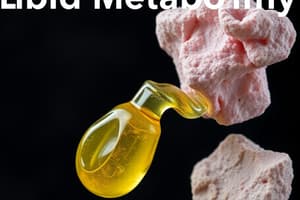Podcast
Questions and Answers
What is the primary function of protein in livestock feeding?
What is the primary function of protein in livestock feeding?
- To support digestive health
- To enhance fat production
- To provide essential amino acids for growth and repair (correct)
- To provide energy for movement
What is the approximate percentage of nitrogen found in protein?
What is the approximate percentage of nitrogen found in protein?
- 16% (correct)
- 10%
- 12%
- 20%
What are the primary components of lipids?
What are the primary components of lipids?
- Carbon, oxygen, and hydrogen (correct)
- Carbon, hydrogen, and iron
- Carbon, oxygen, and calcium
- Carbon, oxygen, and nitrogen
What is the result of undernutrition in animals?
What is the result of undernutrition in animals?
What is the primary role of carbohydrates in animal nutrition?
What is the primary role of carbohydrates in animal nutrition?
What is the main function of minerals in the body?
What is the main function of minerals in the body?
What is the primary function of water in the body?
What is the primary function of water in the body?
What is the comparative energy value of fats versus carbohydrates?
What is the comparative energy value of fats versus carbohydrates?
What is the approximate percentage of composition of most plants and animals that water accounts for?
What is the approximate percentage of composition of most plants and animals that water accounts for?
What is the primary purpose of grading eggs?
What is the primary purpose of grading eggs?
What is the primary method used to examine internal quality factors of eggs?
What is the primary method used to examine internal quality factors of eggs?
What is the minimum average weight for one dozen large eggs?
What is the minimum average weight for one dozen large eggs?
What determines the grade of an egg?
What determines the grade of an egg?
What is the highest grade of egg?
What is the highest grade of egg?
How many different weight categories are used to size eggs?
How many different weight categories are used to size eggs?
Egg grading is only dependent upon external quality factors.
Egg grading is only dependent upon external quality factors.
A jumbo egg weighs at least 33 oz.
A jumbo egg weighs at least 33 oz.
Candling is used to detect eggshell cracks and internal defects.
Candling is used to detect eggshell cracks and internal defects.
The AA grade egg has the least desirable characteristics.
The AA grade egg has the least desirable characteristics.
The size of an egg is determined by its volume.
The size of an egg is determined by its volume.
Egg white and yolk characteristics are factors in determining the grade of an egg.
Egg white and yolk characteristics are factors in determining the grade of an egg.
There are four different weight categories for eggs.
There are four different weight categories for eggs.
Egg grading is a subjective process.
Egg grading is a subjective process.
The minimum average weight for one dozen medium eggs is 21 oz.
The minimum average weight for one dozen medium eggs is 21 oz.
Candling is used to determine the external quality of an egg.
Candling is used to determine the external quality of an egg.
Flashcards are hidden until you start studying
Study Notes
Nutrients
- Lipids: composed of carbon (C), oxygen (O), and hydrogen (H), with larger proportions of carbon and hydrogen than carbohydrates; functions as energy reserves, protection for vital organs, and insulation for the body
- Minerals: found primarily in bones and teeth; essential for heartbeat, nerve transmission, and makeup of important organic materials like blood; divided into macro and micro minerals
- Vitamins: required for health, development, and metabolic reactions; divided into fat-soluble and water-soluble groups
- Water: the most important nutrient, making up 70% or more of plant and animal composition; functions in controlling body temperature, maintaining shape, transporting nutrients and waste, digestion, and as a major part of body fluids
Signs of Unhealthy Birds
- Missing feathers
- Cloudy, dull eyes
- Sneezing
- Panting
- Lethargy
- Reduced feed intake
- Decreased egg production
Egg Nutrition
- One large egg contains: 78 calories, 5g fat, 187mg cholesterol, 0.6g carbohydrates, 6g protein with essential amino acids, and various vitamins and minerals
Egg Grading
- Grading refers to grouping eggs by quality and weight
- Quality assurance performed by company employees
- Antiseptics and disinfectants used in sanitation programs
- Proper nutrition essential for healthy animals
- Physical facilities can contribute to health problems and disease transmission
Nutrition
- Six basic nutrients: protein, carbohydrates, lipids, minerals, vitamins, and water
- Protein: provides essential amino acids, necessary for growth and repair, and contains carbon, hydrogen, oxygen, and nitrogen
- Carbohydrates: used as energy source, largest part of animal feed supply, composed of carbon, oxygen, and hydrogen
- Fats: concentrated energy source, forms cholesterol and other body compounds, affects skin and hair condition when absent from diet
What is Poultry?
- Poultry refers to domestic birds raised for their meat, eggs, or feathers.
- Common types of poultry include chickens, ducks, turkeys, and geese.
Classification of Poultry
- A class is a grouping of breeds based on certain characteristics.
- A breed of poultry is a group of birds with common distinctive characteristics.
- A variety is a subdivision of a breed, with differences in feather colors, comb types, sizes, beards, muffs, and/or feathers on legs.
Life Cycle of a Chicken
- Chickens start as eggs laid by hens.
- Eggs are kept warm in a nest or incubator for 21 days.
- Chicks hatch from eggs and grow into adult chickens.
- Hens lay more eggs to continue the cycle, and a cock fertilizes eggs to create embryos.
Poultry Digestion
- Crop: an expanded, muscular pouch near the gullet or throat.
- Proventriculus: acts as the true stomach of a bird.
- Gizzard: an organ found in the digestive tract of a chicken.
Health
- Temperature of the living conditions: 50-75°F for adult birds.
- Temperature of the bird: 105 to 109°F.
- Heart rate: 220-360 beats per minute.
- Respiratory rate: 12-37 breaths per minute.
Herd Health Management
- Veterinarian-Assisted Planning provides advice on vaccinations, cost-effectiveness, and preventative medical practices.
- Sanitation practices reduce the number of microorganisms entering the animal's body.
- Microorganisms thrive in manure and other organic waste materials, making sanitation crucial.
Minerals
- Needed in nearly all parts of the body, primarily in bones and teeth.
- Make up important parts of many organic materials, including blood.
- Affect heartbeat, nerve transmission, and other vital functions.
- Divided into two groups: macro minerals and micro minerals (or trace minerals).
Vitamins
- Required for health, development, and metabolic reactions.
- Needed in small amounts but are essential for life and health.
- Divided into two groups: fat-soluble and water-soluble.
Water
- The most important nutrient, accounting for 70% or more of the composition of most plants and animals.
- Functions: controls body temperature, enables living plants and animals to hold their shape, involved in transport of nutrients and waste, helps in digestion, and is a major part of all body fluids.
Signs of an Unhealthy Bird
- Missing feathers.
- Cloudy, dull eyes.
- Sneezing.
- Panting.
- Lethargy.
- Reduced feed intake.
- Decreased egg production.
Nutritive Value of an Egg
- Calories: 78.
- Total fat: 5 g.
- Cholesterol: 187 mg.
- Total carbohydrate: 0.6 g.
- Protein: 6 g (with all essential amino acids).
- Vitamins: A, D, B6, B12.
- Minerals: sodium, potassium, calcium, iron, and magnesium.
Grading of an Egg
- Grading refers to the process of grouping eggs according to similar characteristics such as quality and weight.
- Quality assurance is performed by company employees.
- USDA has a stringent set of requirements for the grading of fresh shell eggs.
- Egg grading depends on internal quality factors (e.g., condition of egg white and yolk, air cell size).
- Internal quality factors are determined by candling.
- External quality factors include shape, texture, cleanliness, and soundness of the shell.
Size of Eggs
- Sizes are determined by weight.
- Six different weight categories: peewee, small, medium, large, extra-large, and jumbo.
- Each size category receives a different price on the farm and at the retail level.
- Minimum average weight for one dozen eggs:
- Peewee: 15 oz.
- Small: 18 oz.
- Medium: 21 oz.
- Large: 24 oz.
- Extra-Large: 27 oz.
- Jumbo: 30 oz.
Anatomy of a Chicken
- Various diagrams and images of chicken anatomy are included.
Studying That Suits You
Use AI to generate personalized quizzes and flashcards to suit your learning preferences.




